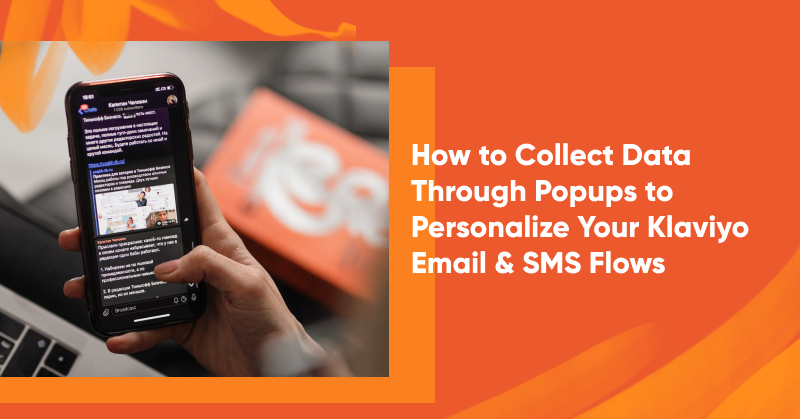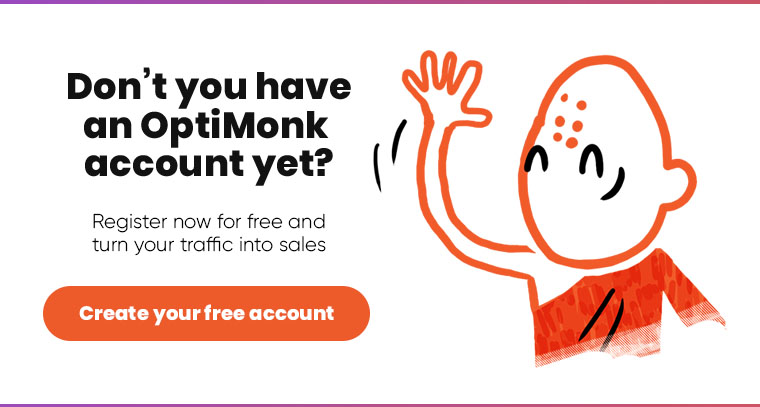Standing out in your subscribers’ inboxes is not as easy as it used to be.
They’re probably subscribed to dozens of other email and SMS lists… So how do you make your emails and text messages compelling enough that your subscribers will open each and every one? The key, we’ll argue, is personalization.
If your emails and text messages look like mass-market blasts, nobody is going to be very interested in opening them. But when your messages look like a 1-on-1 conversation, your subscribers will be much more interested in engaging with them.
And no, we’re not just talking about inserting the first name of the subscriber into the subject line. To stand out, you’ve got to go beyond!
In this article, we’ll discuss why you should use personalization and then cover some practical strategies to help you send targeted messages in Klaviyo.
Let’s get started!
Why personalize your emails and text messages?
When it comes to email and SMS marketing, personalization has become incredibly important for ecommerce stores.
The more you can personalize your content for well-defined segments of users, the more relevant your messaging will be. And relevant messages lead to more revenue because they speak directly to the needs and desires of the customer receiving them.
Statistics back this up: personalized emails generate 5-15% more revenue than those without any personalization.
Plus, 91% of consumers say that they’re more likely to shop with brands that remember their preferences and use them to provide relevant offers and recommendations.
The same study found that 83% of consumers are willing to share their data in order to receive the benefits of a personalized experience.
Other benefits of personalizing your email marketing campaigns include:
- Increased open and click-through rates
- Higher customer engagement
- Decreased unsubscribe rates
These benefits aren’t a secret to marketers, and 94% of businesses say that personalization is critical to their present and future success.
Despite the awareness of the importance of personalization, ecommerce businesses still struggle with collecting the right data about their customers and using it properly in email communications.
This raises the question…
How to collect data about your customers?
Popups are a great way of collecting zero-party data about your customers. You can use them to ask for practically any type of information you want to know about your customers.
With OptiMonk’s Conversational Popups, you aren’t limited to asking for just one or two pieces of information. Instead, you can ask your customers a series of questions about what problems they’re trying to solve and what kind of products they’re interested in.
When your customers tell you directly what their interests are, it’s much easier to create well-defined segments that you can use to craft carefully tailored messages.
Here’s the simplest conversational popup sequence:
- Ask a question and provide a few answer choices
- Collect visitors’ email addresses
- Recommend products based on their answer
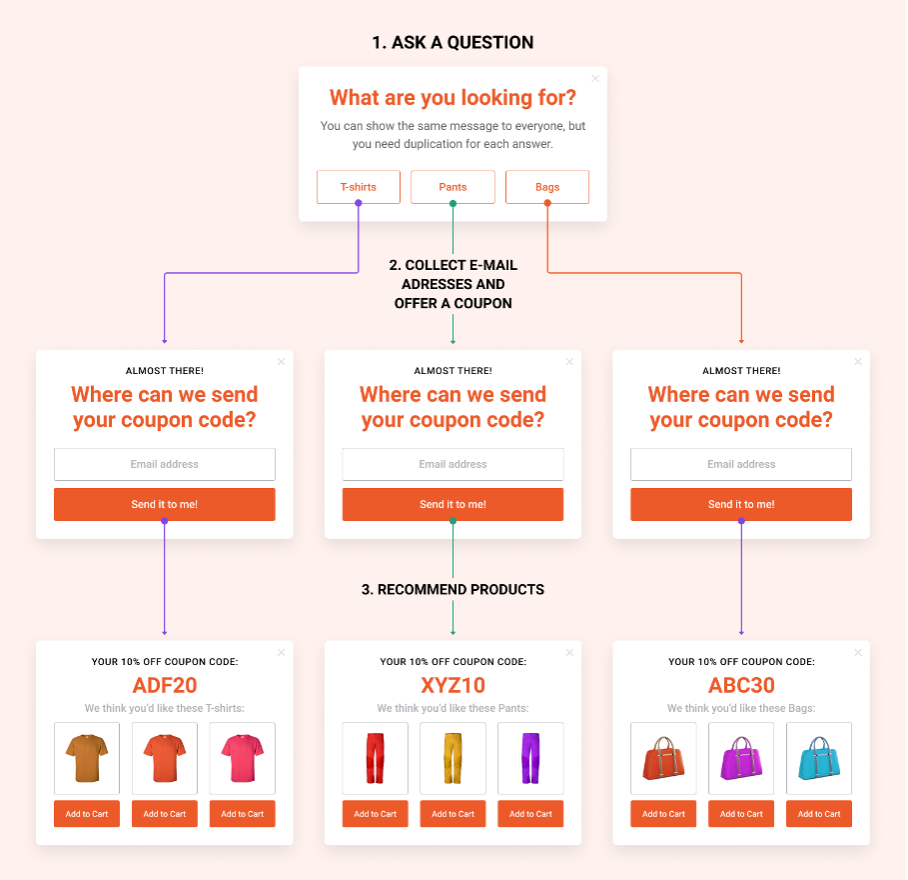
But you can add as many more question/answer combinations as you like to collect more customer data.
If you’re worried about asking too many questions and annoying your visitors, it’s often a good idea to frame these sequences as “quizzes” that will help your customers learn something about themselves.
Customers love to engage with these popups. Our internal data indicates that they convert, on average, 15.2% of impressions.
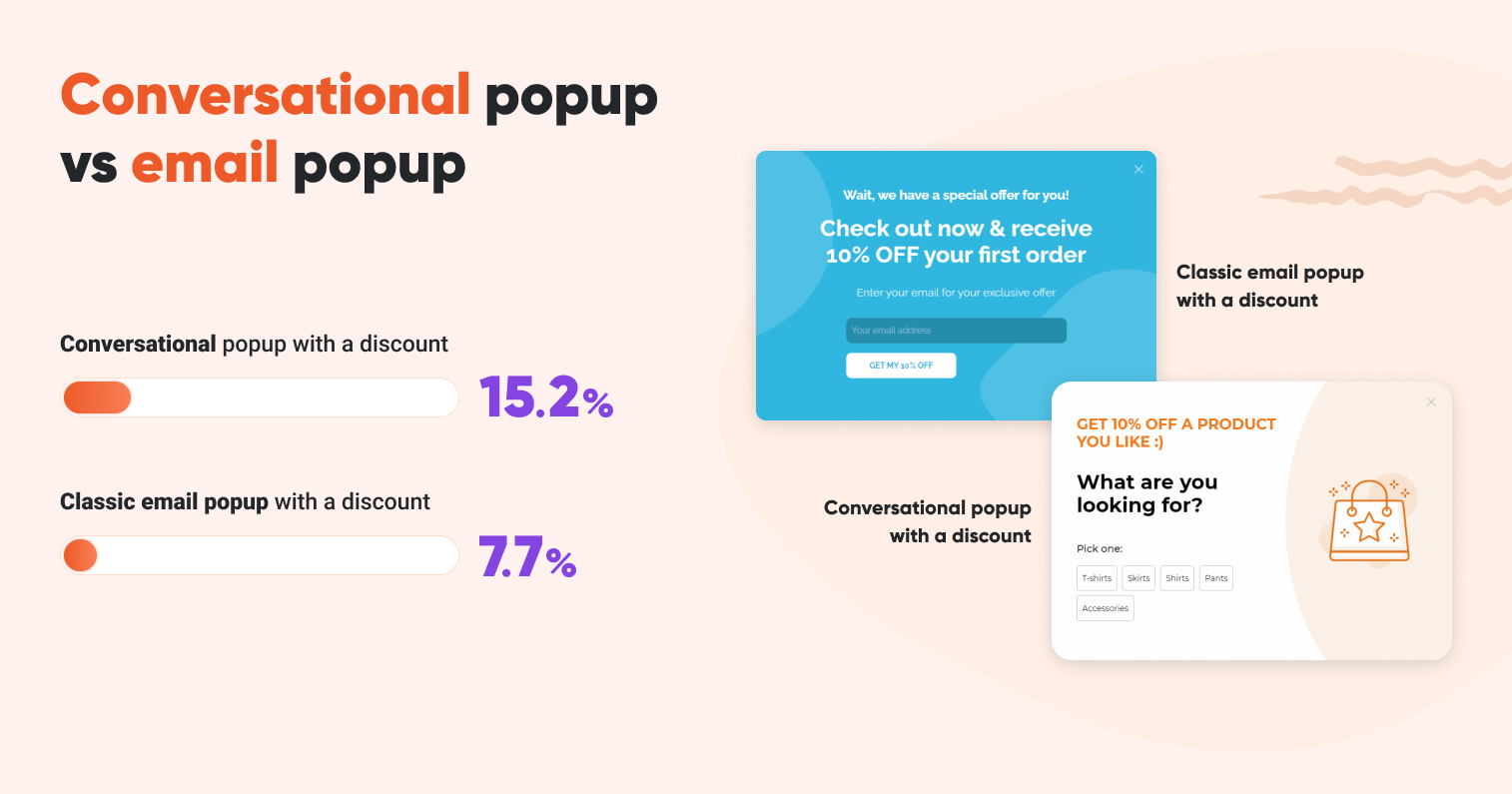
Here are some more of our conversational popup templates that you can start customizing for your online store with just a few clicks:
A step-by-step guide to personalizing Klaviyo messages using OptiMonk popup data
As you’ll see in this section, all the personalized data you collect using OptiMonk popups can easily be transferred to your Klaviyo account so you can personalize your email marketing campaigns and send targeted messages.
Let’s see how!
Step 1: Integrate Klaviyo & OptiMonk
OptiMonk’s Klaviyo integration allows you to connect your Klaviyo account to OptiMonk in minutes. This will automatically send all the new email addresses and phone numbers collected with OptiMonk popups directly to Klaviyo.
And you can even send different segments of users to different Klaviyo lists (meaning you can send them different welcome emails).
To help explain the integration process, we’ve created an example using one of our pre-made templates. Let’s pretend we’re running a skincare brand and we’ve created the following campaign:
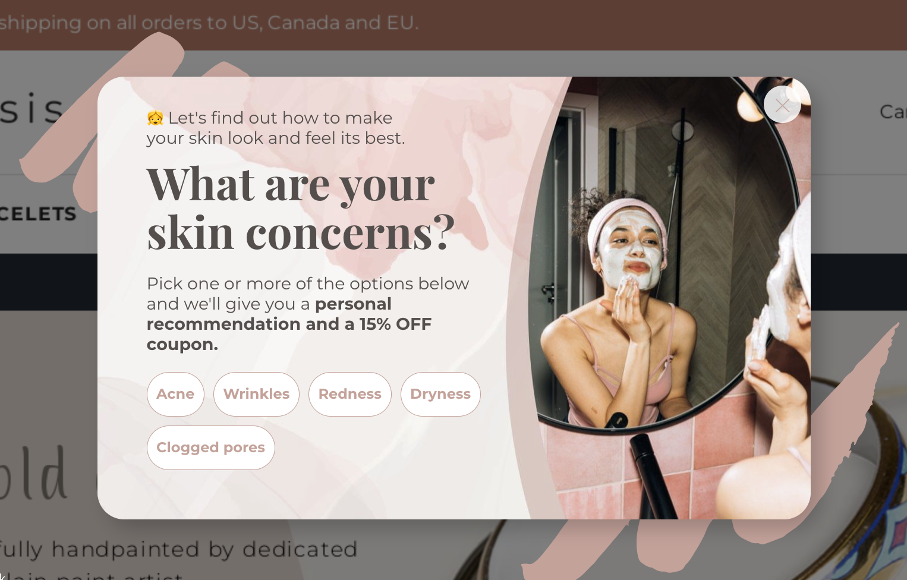
To connect your Klaviyo account to OptiMonk, head over to the settings of your OptiMonk campaign and navigate to the “Add Integration” menu…

… and then select Klaviyo from the list:

Now, grab your API key from your Klaviyo account and paste it into the proper field in your OptiMonk account:

The last thing you need to set up in OptiMonk is the “Field identifier in Klaviyo” that links each input field of your OptiMonk Campaign to the corresponding field in Klaviyo.
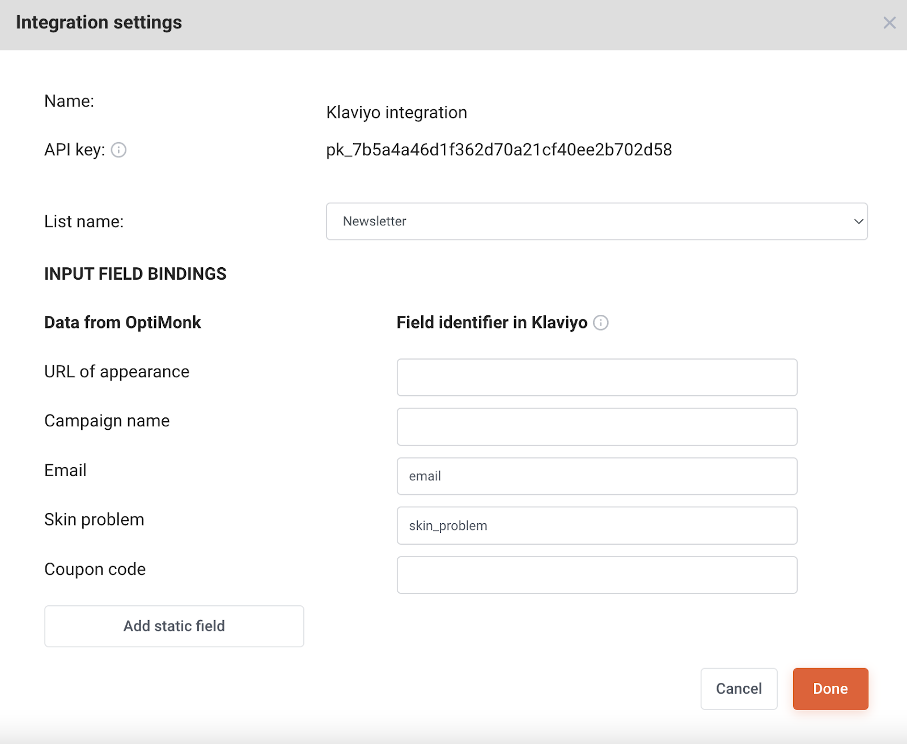
In the example above, the “skin problem” data from OptiMonk will contain the answer to the question from our popup “What are your skin concerns?” This data will help you to personalize your messages in the future.
Step 2: Create segments in your Klaviyo account
Now we’ll head over to Klaviyo and create different customer segments based on the data we collect from the OptiMonk popup.
Let’s take a second look at our skincare conversational popup:

Our goal is to send the customers who choose each of these different options into different Klaviyo segments.
First, click on the “Lists & Segments” section in Klaviyo. Then, click on “Create List/Segment” and choose “Segment.”
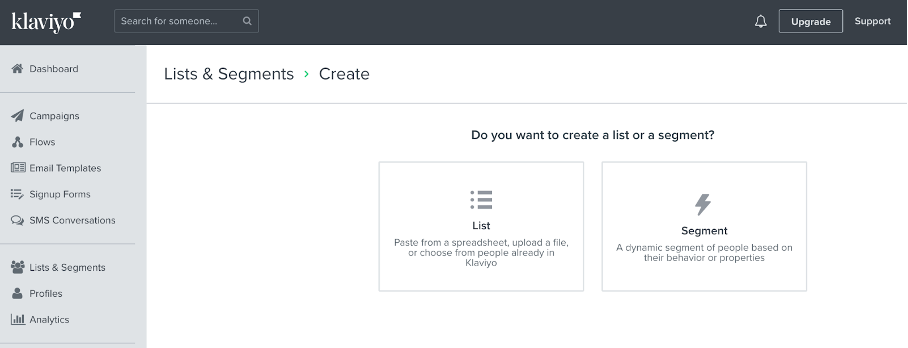
For each answer to our question about visitors’ biggest skin problem, we’ll create a segment as follows:
First, we’ll name the segment—let’s start with “Skin problem is acne.”

Then, we’ll have to define what that means by selecting “Properties about someone” in the drop-down menu:
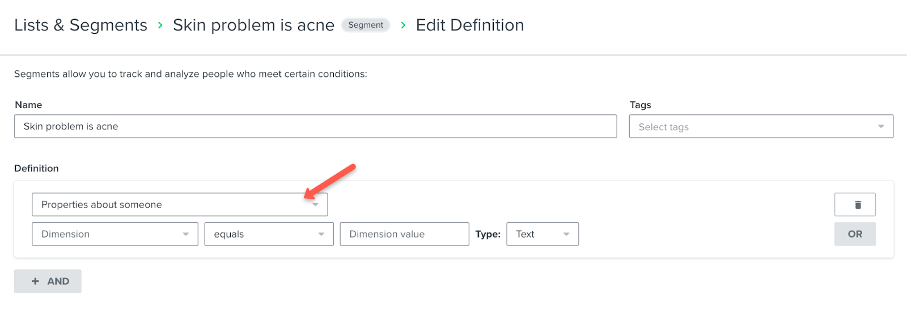
Since we’re working on the “skin problem is acne” segment, we want to add “skin_problem” as a dimension (this is the name of the field we’re sending over to Klaviyo from OptiMonk), then select “equals” in the second dropdown menu and write “Acne” as the dimension value:

This tells Klaviyo that whenever a visitor selects “Acne” on our quiz, they belong in the “skin problem is acne” segment.
Then, click the “Create segment” button and you’re done with the first one! Now, just repeat the process to create different segments for visitors who answered Wrinkles, Redness, Dryness, or Clogged Pores.
Now you’ll be able to create different email messages for each of these segments. For example, you could email your new acne product to the group of people who said they have acne, while sending an anti-wrinkle product to the “skin problem is wrinkles” segment.
Step 3: Personalize emails and text messages in your Klaviyo account
Once you’ve set all this up, it’s time to personalize your email and mass text messages based on all the data you collected through OptiMonk.
In this example, in addition to the email address and skin care problems, we’re also transferring an OptiMonk coupon code to our Klaviyo list.
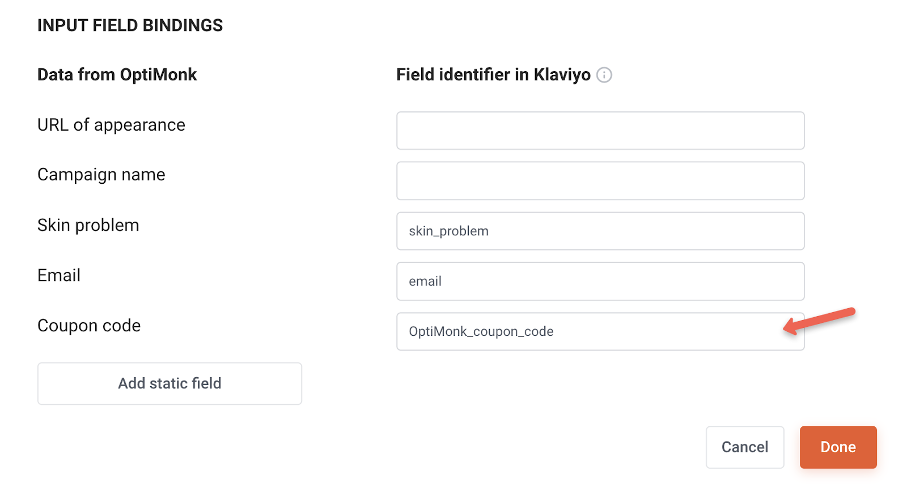
You can enter any name you wish as a “Field identifier in Klaviyo.” In this case, we used “OptiMonk_coupon_code.” This will automatically create an element that you can add to your Klaviyo email templates.
By inserting this property into your emails, you can include your subscriber’s unique coupon code automatically.
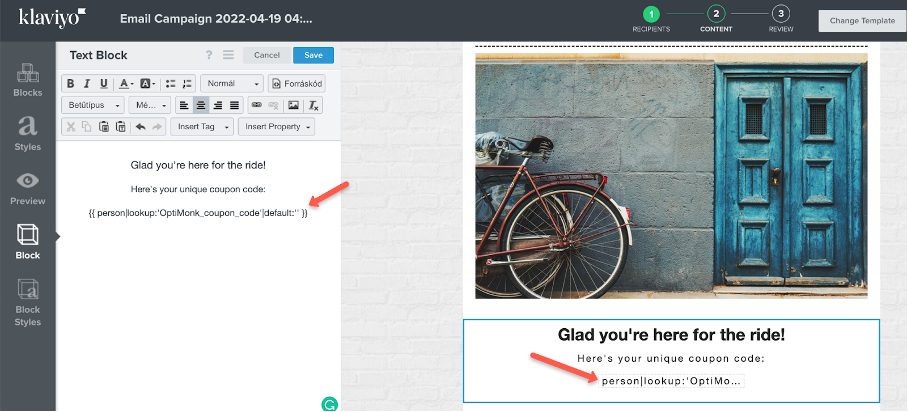
Our imaginary campaign is just one example. You can ask for any custom data you like (and that makes sense for your business) like favorite colors, birthdays, or even preferred days to be contacted.
Using the exact same process, you can transfer this data to Klaviyo and use it to personalize your email or SMS campaigns.
FAQ
What is Klaviyo?
Klaviyo is a popular email marketing platform known for its robust personalization features. It enables you to create highly targeted email campaigns based on customer behavior, preferences, and demographics.
How does Klaviyo facilitate personalization?
Klaviyo leverages customer data to create personalized email campaigns. It integrates with various ecommerce platforms and other data sources to gather information such as purchase history, browsing behavior, and demographic data. You can also collect zero-party data with tools like OptiMonk, and then use this data to send targeted messages to different audience segments.
How can businesses measure the effectiveness of their personalization efforts with Klaviyo?
Klaviyo provides analytics and reporting tools to track the performance of your email campaigns. You can monitor metrics such as open rates, click-through rates, conversion rates, and revenue generated.
Recap
We hope you’ve found some useful info in our explanation of how to take full advantage of the integration between OptiMonk and Klaviyo.
Personalizing your email and SMS campaigns using this method can immediately lead to 5-15% more revenue!
Get started with one of our ready-to-use templates now, sync all the data into your Klaviyo account and personalize your messages easily. Click here to create a free OptiMonk account!
